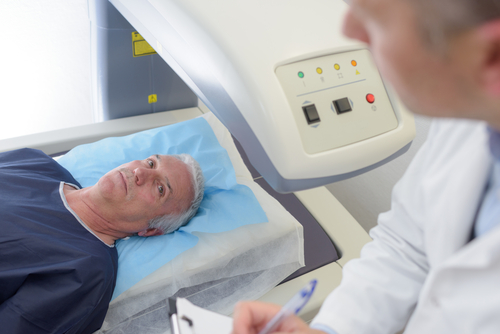68Ga-PSMA-11 PET scans are highly accurate, reproducible, and safe for detecting prostate cancer that has come back after prior therapy with prostate surgery or radiation therapy, a study shows.
The report, “Assessment of 68Ga-PSMA-11 PET Accuracy in Localizing Recurrent Prostate Cancer,” was published in the journal JAMA Oncology.
In men whose prostate cancer has come back — seen by a rise in prostate-specific antigen (PSA) blood tests — international guidelines recommend computed tomography (CT), magnetic resonance imaging (MRI), and bone scans to visualize the cancer’s location and whether it has spread.
But these imaging techniques may have low sensitivity, specifically when PSA levels are low. Thus, researchers have been developing tracers for positron emission tomography (PET) imaging that light up prostate cancer before it is evident on other imaging tests.
PET scans use probes called radiotracers, which are specific molecules linked to or “labeled” with a small bit of radioactive material, making them detectable on the scan. The non-radioactive part of a radiotracer is a molecule designed to accumulate in cancers or regions of inflammation, or bind specific proteins in the body.
Several studies have demonstrated that one PET probe — 68Ga-PSMA-11 — yields “unprecedented accuracy and effect on treatment,” researchers noted. It is composed of a molecule that binds the prostate specific membrane antigen (PSMA), labeled with the radioactive compound gallium (68G).
Although this technique has been used on a compassionate basis and evaluated in multiple case studies outside the U.S., there is a lack of prospective data — a study that watches for outcomes over the study period, rather than looking at data obtained in the past (retrospective study).
To obtain this type of data, a team led by physicians at University of California Los Angeles (UCLA) and University of California San Francisco, conducted two clinical trials to investigate how good 68Ga-PSMA-11 PET imaging is for detecting prostate cancer that has come back after initial therapy.
The studies (NCT02940262 and NCT03353740) measured the positive predictive value, detection rate, reproducibility, and safety of 68Ga-PSMA-11 PET in 635 patients, ages 44 to 95, who had biochemical recurrence of prostate cancer (evidenced by PSA tests) after prior treatment with surgery, radiation therapy, or both.
Results showed that 68Ga-PSMA-11 PET had a positive predictive value — the probability that subjects testing positive on the scan truly have the disease — ranging from 84% to 92%, depending on whether tumors were validated by biopsy or a composite assessment that also included PSA levels.
The scan detected and localized recurrent prostate cancer in 475 of 635 (75%) patients with a PSA test indicative of cancer recurrence.
PET scans were able to detect more recurrent patients, as their PSA levels were higher. Detection rates were 38%, 57%, 84%, 86%, and 97% as PSA levels ranged from less than 0.5, 0.5 to less than 1, 1 to less than 2, 2 to less than 5, and 5 or more ng/mL.
Each scan was repeated three times on different PET readers to test a reader’s reproducibility, which was considered to be “substantial.” No serious adverse events were observed with 68Ga-PSMA-11 administration.
In a small group of patients, lesions identified by PET scans were therapeutically targeted either using radiation therapy, surgery, or cryoablation. This type of PET-directed focal therapy alone led to a PSA reduction of 50% or greater in 31 out of 39 patients (80%).
“This prospective multi-center trial demonstrates high accuracy, reproducibility, and safety of 68Ga-PSMA-11 PET in patients with biochemically recurrent prostate cancer,” researchers said.
Compared with prior analysis, this study is strengthened by its large sample of patients, the blind reproducibility tests of PET readers, and independent validation of tumors.
“High rates of biochemical response (≥80%) in patients with PET-directed focal therapy indicate potential value of the PET information for treatment planning,” the researchers said. However, these results must be interpreted with caution, as a potential benefit “needs to be carefully weighed against potential morbidity and complexity of salvage procedures in clinical trials,” they said.
PET false-negative lesions were reported in few patients (17) and half of those were associated with weak uptake of the radiotracer by the tumors. These false negatives may also happen because of elimination of the tracer in urine, inflammation, or post-therapeutic remodeling, low or absent PSMA expression, or small tumor size.
Another promising PET modality for prostate cancer, 18F-fluciclovine PET, is not yet approved. Comparison between 68Ga-PSMA-11 vs 18F-fluciclovine PET for recurrent prostate cancer is underway on a clinical trial at UCLA (NCT03515577).

